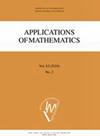显式两步龙格-库塔方法
IF 0.6
4区 数学
Q4 MATHEMATICS, APPLIED
引用次数: 30
摘要
分析了常微分方程数值解的显式两步龙格-库塔(TSRK)公式。推导了有序条件,并在一些简化假设的基础上描述了这种方法的构造。秩序障碍也被提出。结果表明,对于阶为$p$的显式TSRK法的最小阶数等于阶为$p$的显式龙格-库塔法的最小阶数。数值结果表明,定步长TSRK可以有效地用于求解欧拉方程。此外,与可变步长公式的比较表明,在这些求解器中,与恒定步长实现相比,可变步长公式没有优势。本文章由计算机程序翻译,如有差异,请以英文原文为准。
Explicit two-step Runge-Kutta methods
The explicit two-step Runge-Kutta (TSRK) formulas for the numerical solution of ordinary differential equations are analyzed. The order conditions are derived and the construction of such methods based on some simplifying assumptions is described. Order barriers are also presented. It turns out that for order $p\le 5$ the minimal number of stages for explicit TSRK method of order $p$ is equal to the minimal number of stages for explicit Runge-Kutta method of order $p-1$. Numerical results are presented which demonstrate that constant step size TSRK can be both effectively and efficiently used in an Euler equation solver. Furthermore, a comparison with a variable step size formulation shows that in these solvers the variable step size formulation offers no advantages compared to the constant step size implementation.
求助全文
通过发布文献求助,成功后即可免费获取论文全文。
去求助
来源期刊

Applications of Mathematics
数学-应用数学
CiteScore
1.50
自引率
0.00%
发文量
0
审稿时长
3.0 months
期刊介绍:
Applications of Mathematics publishes original high quality research papers that are directed towards applications of mathematical methods in various branches of science and engineering.
The main topics covered include:
- Mechanics of Solids;
- Fluid Mechanics;
- Electrical Engineering;
- Solutions of Differential and Integral Equations;
- Mathematical Physics;
- Optimization;
- Probability
Mathematical Statistics.
The journal is of interest to a wide audience of mathematicians, scientists and engineers concerned with the development of scientific computing, mathematical statistics and applicable mathematics in general.
 求助内容:
求助内容: 应助结果提醒方式:
应助结果提醒方式:


